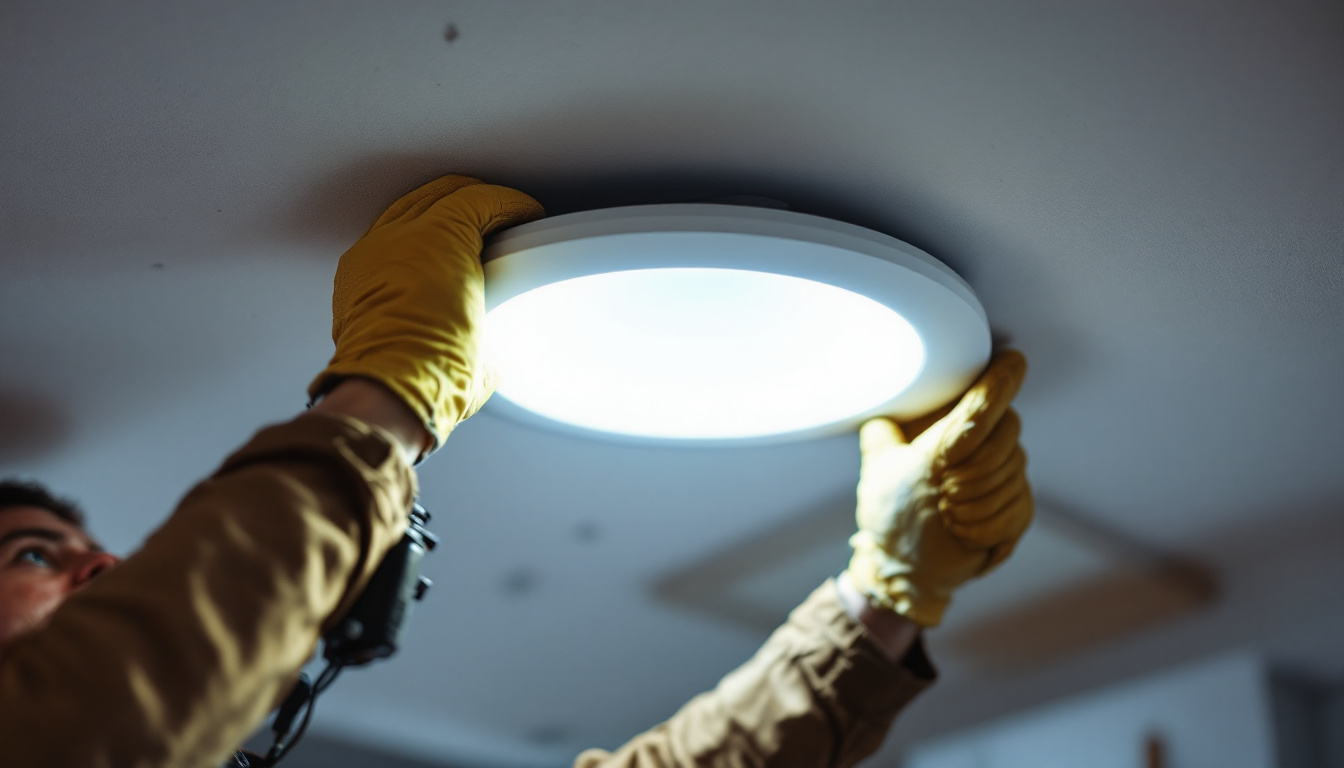
In the realm of commercial and residential lighting, drop ceiling lights play a crucial role in enhancing both aesthetics and functionality. For lighting contractors, understanding the science behind these fixtures is essential for effective installation and optimal performance. This article delves into the various aspects of drop ceiling lights, including their design, functionality, and installation considerations, providing valuable insights for professionals in the field.
Drop ceiling lights, often referred to as troffer lights, are fixtures designed to be installed in a suspended ceiling grid. These lights are typically rectangular and fit seamlessly into the ceiling tiles, providing a clean and modern look. They are widely used in commercial spaces such as offices, schools, and retail environments due to their versatility and efficiency.
The design of drop ceiling lights is not just about functionality; it also plays a significant role in the overall aesthetics of a space. These fixtures come in various styles, including recessed, surface-mounted, and pendant options. The choice of design can influence the ambiance of a room, making it essential for contractors to consider the specific needs of their clients.
Moreover, the finish and materials used in drop ceiling lights can impact their visual appeal. Options range from sleek aluminum to more traditional finishes, allowing contractors to match the lighting fixtures with the interior design of the space. This attention to detail can enhance the overall perception of quality in a project. Additionally, the color temperature of the light emitted can also affect the mood of the environment; warmer tones can create a cozy atmosphere, while cooler tones are often more energizing and suitable for workspaces.
There are several types of drop ceiling lights available, each serving different purposes and environments. The most common types include:
In addition to these common types, there are also specialty drop ceiling lights designed for specific applications. For instance, some fixtures are engineered for high ceilings or areas that require enhanced durability, such as warehouses or manufacturing facilities. These lights often come with features like impact-resistant lenses and moisture-proof designs, ensuring they can withstand harsher environments. Furthermore, the integration of dimmable options in many drop ceiling lights allows for customizable brightness levels, catering to different activities and preferences throughout the day.
Another emerging trend in the realm of drop ceiling lighting is the incorporation of biophilic design principles. This approach emphasizes the connection between indoor environments and nature, leading to the development of fixtures that mimic natural light patterns. By utilizing tunable white LEDs, these lights can adjust their color temperature throughout the day, promoting well-being and productivity among occupants. As sustainability becomes a priority in design, drop ceiling lights that incorporate energy-efficient technologies and materials are increasingly sought after, aligning with the goals of eco-conscious businesses and organizations.
To effectively work with drop ceiling lights, contractors must grasp the fundamental principles of light. This knowledge not only aids in selecting the right fixtures but also ensures that the lighting meets the functional requirements of the space.
Illumination is measured in lumens, which quantify the total amount of visible light emitted by a source. Understanding the lumen output of different drop ceiling lights is crucial for achieving the desired brightness in various environments. For instance, a typical office space may require around 300-500 lumens per square meter to ensure adequate visibility for tasks.
Contractors must also consider the concept of brightness perception, which can be influenced by factors such as color temperature and the surrounding environment. Cooler color temperatures (5000K-6500K) tend to create a more vibrant atmosphere, while warmer temperatures (2700K-3000K) can promote a cozy and inviting feel. Additionally, the layout and design of the space can significantly affect how light is distributed and perceived; for example, high ceilings may necessitate fixtures with higher lumen outputs to maintain even illumination throughout the area.
The Color Rendering Index (CRI) is a critical factor in evaluating the quality of light produced by a fixture. It measures how accurately a light source displays colors compared to natural light. A higher CRI (above 80) is generally preferred in settings where color accuracy is essential, such as in retail or art galleries.
For lighting contractors, selecting fixtures with an appropriate CRI ensures that colors appear true to life, enhancing the overall experience of the space. This is particularly important in environments where visual tasks are performed, as poor color rendering can lead to eye strain and discomfort. Moreover, understanding the interplay between CRI and other factors, such as the light source’s spectral distribution, can help contractors make informed decisions. For example, LED lights often have a higher CRI compared to traditional fluorescent bulbs, making them a popular choice for spaces that require precise color differentiation, such as design studios or hospitals, where accurate color perception can impact outcomes significantly.
Proper installation of drop ceiling lights is vital for achieving optimal performance and longevity. Lighting contractors must be aware of various factors that can influence the installation process.
Before installation, it is essential to assess the compatibility of the drop ceiling lights with the existing ceiling grid. Different grids may have varying load capacities and configurations, which can affect the choice of fixtures. Contractors should ensure that the selected lights fit securely within the grid while also providing adequate support.
Additionally, understanding the layout of the ceiling grid is critical for achieving uniform lighting distribution. Proper spacing between fixtures can prevent dark spots and ensure that the entire area is adequately illuminated.
Electrical wiring is a fundamental aspect of installing drop ceiling lights. Contractors must adhere to local building codes and regulations when connecting fixtures to the electrical supply. This includes ensuring that the circuit can handle the load of the installed lights and that proper safety measures are in place.
Moreover, the choice of ballast or driver is essential, especially when working with LED fixtures. Selecting the appropriate driver ensures compatibility and optimal performance, preventing flickering or premature failure of the lights.
As energy efficiency becomes increasingly important in the lighting industry, drop ceiling lights have evolved to meet these demands. Contractors must stay informed about the latest advancements in energy-efficient lighting solutions.
LED technology has revolutionized the lighting landscape, offering significant advantages over traditional incandescent and fluorescent options. LED drop ceiling lights consume considerably less energy while providing the same, if not better, light output. This not only reduces electricity costs but also contributes to a lower carbon footprint.
Furthermore, LED fixtures have a longer lifespan, resulting in fewer replacements and reduced waste. For contractors, promoting energy-efficient solutions can enhance their reputation and appeal to environmentally conscious clients.
Many regions have implemented building codes and incentives to encourage the use of energy-efficient lighting solutions. Understanding these regulations can help contractors navigate the complexities of compliance while also taking advantage of potential rebates or tax incentives for their clients.
By staying informed about local policies, contractors can position themselves as knowledgeable professionals who prioritize sustainability in their projects.
The lighting industry is constantly evolving, and staying ahead of trends is essential for contractors looking to remain competitive. Several emerging trends in drop ceiling lighting are worth noting.
As smart home technology continues to gain popularity, integrating smart lighting solutions into drop ceiling fixtures is becoming increasingly common. These systems allow for remote control, automation, and the ability to customize lighting settings based on user preferences.
Contractors who embrace smart lighting technology can offer clients enhanced convenience and energy savings, making their services more appealing in a competitive market.
Human-centric lighting focuses on creating environments that support the well-being and productivity of occupants. This approach considers factors such as circadian rhythms and the psychological effects of light on mood and performance.
Contractors who understand the principles of human-centric lighting can design spaces that not only look good but also promote health and productivity. This knowledge can set them apart in a crowded industry, appealing to clients who prioritize employee well-being and comfort.
Drop ceiling lights are an integral component of modern lighting design, offering versatility, efficiency, and aesthetic appeal. For lighting contractors, understanding the science behind these fixtures is essential for successful installation and client satisfaction. By grasping the principles of illumination, energy efficiency, and emerging trends, contractors can position themselves as experts in the field.
As the lighting landscape continues to evolve, staying informed about advancements and best practices will empower contractors to deliver exceptional results in their projects. By prioritizing quality, sustainability, and innovation, lighting professionals can not only meet but exceed the expectations of their clients, ensuring a bright future for their businesses.
Ready to elevate your lighting projects with the highest quality drop ceiling lights? At LumenWholesale, we provide lighting contractors like you with spec-grade lighting solutions that combine quality, affordability, and convenience. Say goodbye to local distributor markups and hello to our extensive selection of premium lighting products at wholesale prices. Plus, with free shipping on bulk orders, you can ensure your projects shine without any hidden costs. Don’t compromise on performance or price. Discover the best value in wholesale lighting and make LumenWholesale your go-to source for all your lighting needs.

Discover how optimizing office lighting can be a game-changer for lighting contractors.

Discover how lighting contractors can enhance their expertise by mastering the installation and selection of commercial ceiling fans.

Discover expert insights and quick tips from lighting contractors on replacing recessed LED lights.

Discover how low voltage wire connectors can enhance efficiency and reliability for lighting contractors.